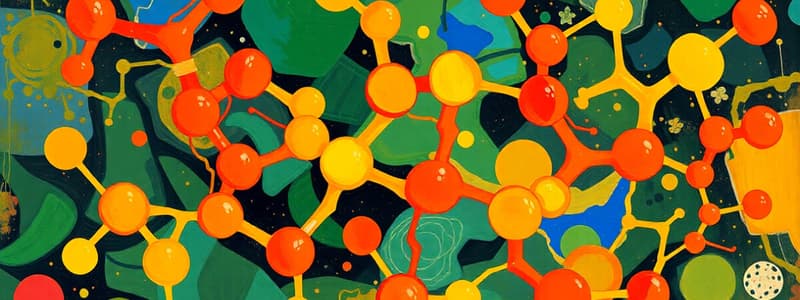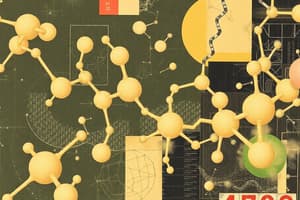Podcast
Questions and Answers
What is the primary function of glycogen in animals?
What is the primary function of glycogen in animals?
- Long-term energy storage
- Short-term energy storage (correct)
- Formation of polysaccharides
- Structural support in cell walls
Which of the following statements about starch is correct?
Which of the following statements about starch is correct?
- Amylopectin constitutes the majority of starch and is easier to digest. (correct)
- Amylose is a water-soluble unbranched form of starch.
- Starch is primarily used for structural support in plants.
- Starch consists entirely of β-glucose molecules.
What distinguishes cellulose from glycogen and starch?
What distinguishes cellulose from glycogen and starch?
- Cellulose cannot be digested by humans. (correct)
- Cellulose contains an amine group in its monomers.
- Cellulose is a short-term energy storage polymer.
- Cellulose is composed of α-glucose monomers.
What is a significant characteristic of chitin?
What is a significant characteristic of chitin?
Which of the following describes the bonding in cellulose?
Which of the following describes the bonding in cellulose?
What is the primary function of carbohydrates in the body?
What is the primary function of carbohydrates in the body?
What is the general formula for carbohydrates represented as?
What is the general formula for carbohydrates represented as?
Which of the following describes a disaccharide?
Which of the following describes a disaccharide?
Which reaction is responsible for the formation of glycosidic linkages in carbohydrates?
Which reaction is responsible for the formation of glycosidic linkages in carbohydrates?
Which monosaccharides are considered isomers of each other?
Which monosaccharides are considered isomers of each other?
Study Notes
Carbohydrates
- Function: Provides fast energy for the body, acts as building material and structural support
- Occur in multiple forms: monosaccharide, disaccharide, or polysaccharide
- Consist of C, H, and O atoms typically in a 1:2:1 ratio - has a general formula of (CH2O)n
- Form ring structures in aqueous solutions
Monosaccharides
- Monomer of carbohydrates
- Simple sugars, 1 ring (3-7 carbons)
- Classified by number of carbons
- Major sources of fuel
- Carbon skeleton serves as raw material for the production of other macromolecules
- Functional Groups: OH – hydroxyl
Monosaccharides (important structures)
- Know the structures of glucose, galactose, and fructose
- Be able to link any two of them together to form a disaccharide
Monosaccharides (isomers)
- Glucose, galactose, and fructose are isomers (same formula but different structures) of each other
- Each individual monosaccharide also has multiple different isomers such as α-glucose and β-glucose
Disaccharides
- Two monosaccharides are covalently bonded together by a glycosidic linkage
- Formed by a condensation (dehydration synthesis) reaction
- Water is removed from two hydroxyl groups
Condensation (Dehydration Synthesis) Reaction
- Note: that the glycosidic linkage is made between two hydroxyl functional groups!
Disaccharide examples
- α-glucose + α-glucose = maltose
- α-glucose + fructose = sucrose
- β-glucose + galactose = lactose
Polysaccharides
- Several hundred to thousands of monosaccharides bonded together
- Examples: glycogen, starch, cellulose, chitin
- Function: energy storage or structural molecules
Storage Polysaccharides: Glycogen (Animal)
- Short-term energy storage
- Depleted in one day unless storage is replenished by consumption of food
- Chains of α-glucose molecules
- Highly branched
- Glycogen is hydrolyzed (broken apart into glucose monomers) when blood sugar drops
Storage Polysaccharides: Starch (Plant)
- Short-term energy storage
- Long chains of α-glucose molecules
- Amylose is a type of simple starch that is unbranched (20-30% of the starch, hard to digest – insoluble in water)
- Amylopectin is a complex starch that is branched (70% of the starch, soluble, easy to degrade – has many enzyme attachment points)
Structural Polysaccharides: Chitin
- Exoskeleton of insects and crustaceans
- Cell wall of fungi
- β-glucose monomers contain an amine group
Structural Polysaccharides: Cellulose (Plant)
- Major component of cell walls
- Cannot be digested by humans (we lack the enzyme)
- Consists of β-glucose polymers bonded by beta 1-4 glycosidic linkages
Studying That Suits You
Use AI to generate personalized quizzes and flashcards to suit your learning preferences.
Related Documents
Description
This quiz covers the essential aspects of carbohydrates, focusing on their function, structure, and the different types of monosaccharides. Test your knowledge of simple sugars, their isomers, and how they link to form disaccharides. Understand the fundamental roles carbohydrates play in providing energy and supporting macromolecule production.




